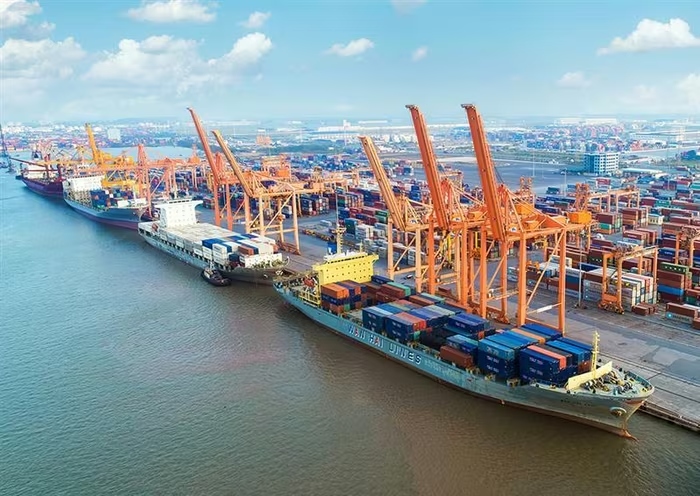By the end of Q3/2025, the performance of Vietnam’s port enterprises showed clear signs of recovery. Among them, Hai Phong Port JSC – one of the largest and most strategically important ports in the northern seaport system – recorded impressive standalone business results.

Cargo throughput at ports has been growing recently, contributing to positive business results for seaport enterprises. Illustrative photo.
Net revenue from sales and service provision of the company reached over VND 442 billion, reflecting the continuing positive growth momentum of cargo throughput.
Hai Phong Port’s post-tax profit reached more than VND 395 billion, up 43% year-on-year. Accumulated in the first nine months of 2025, total post-tax profit reached VND 859 billion, an increase of 53% compared to the same period in 2024.
The company explained that, besides strong growth in core operations, this result was also driven by other income — mainly from the revaluation of contributed asset values in subsidiaries and joint ventures such as Hoang Dieu – Chua Ve Port Co., Ltd. and TIL Hai Phong International Port Co., Ltd.
Not only in Hai Phong, but seaport enterprises in the Central and Southern regions also reported profits. Da Nang Port JSC recorded Q3 revenue of VND 416 billion, up 13.5% year-on-year. Post-tax profit reached VND 111.7 billion, up 40.5%, while cumulative post-tax profit for the first nine months hit VND 292.9 billion, up 27%.
The company’s representative explained that total cargo throughput at the port in the quarter increased by 13.45%, driving strong growth in service revenue. Another key factor improving profitability was the land rent exemption policy in 2024, which significantly reduced operating costs.
In Khanh Hoa, Cam Ranh Port JSC also achieved positive results. In Q3, consolidated profit reached over VND 7.2 billion, up 71% year-on-year. For the first nine months, profit reached VND 17.9 billion, an increase of 38.7%. According to the company, the sharp rise in cargo throughput at Cam Ranh Port compared to 2024 helped improve profit margins and business efficiency.
In Binh Dinh, Quy Nhon Port JSC recorded consolidated net revenue of nearly VND 303 billion in Q3, up nearly 3% year-on-year. Post-tax profit reached VND 35.1 billion, an increase of 38.4%. Overall, in the first nine months of 2025, the company achieved net revenue of VND 833.6 billion and post-tax profit of over VND 100.3 billion.
Quy Nhon Port explained that the strong profit growth was due to a 30% reduction in land rent in 2024 under new regulations, along with undistributed post-tax profit from a subsidiary worth more than VND 5.5 billion.
In the South, positive signals were also recorded. Cat Lai Port JSC announced consolidated post-tax profit in Q3 of more than VND 31.2 billion, up 14% from the same period in 2024. The company attributed this mainly to the strong profit growth of its subsidiaries, which contributed positively to the consolidated results.
Meanwhile, Gemadept JSC — which owns a seaport system stretching from North to South — reported consolidated net revenue in Q3 of over VND 1,560 billion, slightly up year-on-year. However, post-tax profit fell slightly to more than VND 432 billion.
Nevertheless, Gemadept’s accumulated post-tax profit for the first nine months of 2025 still reached over VND 1,564 billion, up nearly 1% from the previous year, demonstrating the group’s ability to maintain stable business performance amid market fluctuations.
Driven by Economic Momentum
According to the Vietnam Maritime and Inland Waterways Administration, total cargo volume through the nation’s seaports reached over 863 million tons, an increase of more than 10% compared to the same period in 2024. This figure reflects the recovery of trade and logistics activities, as well as the strong momentum of Vietnam’s economy — particularly in import-export sectors.
However, observers noted that the seaport industry still faces various global challenges. Factors such as geopolitical tensions, shipping rate volatility, alliance restructuring among shipping lines, and changing tariff policies are all affecting cargo handling and maritime transport activities.
Nevertheless, according to the Vietnam Industry and Trade Information Center (Ministry of Industry and Trade), the overall economic environment in Vietnam remains positive. Strong advances in digitalization, administrative reform, enhanced transparency, and trade facilitation continue to make Vietnam an attractive destination for investors and international businesses.
In response to market fluctuations, logistics enterprises and shippers are actively adjusting their business strategies — increasing flexibility, diversifying supply sources, adopting digital technologies, and expanding partnerships across the supply chain. This is seen as a necessary direction to help Vietnam’s seaport industry better adapt and sustain long-term growth in the coming period.